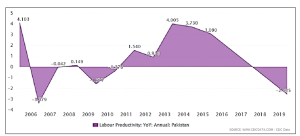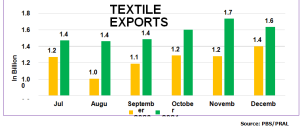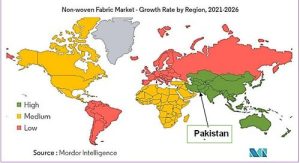Productivity isn’t everything, but in the long run, it is almost everything. A country’s ability to improve its standard of living over time depends almost entirely on its ability to raise its output per worker.
Paul Krugman, The Age of Diminishing Expectations (1994)
Productivity is frequently demarcated as a ratio between the output volume and the volume of inputs
More specifically put, it revolves around the notion of measuring the efficiency of production inputs including but not limited to labor, capital inter alia in order to generate a certain degree of output in a given economy. It is considered a pertinent source of economic growth and thereby enhances competitiveness in the market. Moreover, it is an important indicator when cross-country comparison is being done in terms of economic performance.
Read more: Debunking the relationship between exports and currency devaluation
This can be elucidated by the fact that productivity data sets of any country are majorly used to explore the influence of products coupled with the market regulations on the economic performance of the country, as stated by the Organization for Economic Co-operation and Development (OECD). Using such data sets, a projection of the future productive capacity of different economies is made possible. Likewise, analysts and policymakers are in a vibrant position to effectively determine and regulate how to utilize this capacity while appraising the locus of economies in the business cycle, consequently, forecasting the economic growth. It is also used to evaluate demand and inflationary compressions.
Considering the aforementioned background information, the importance of productivity is crisp and clear. Unfortunately, for a developing country like Pakistan, productivity is an issue that it has been facing for decades now, even after its inception seventy-four years ago in 1947. The current situation of productivity in Pakistan is catastrophic in nature whereby the country is running low on productivity. This can be reinforced through the fact that according to Global Economic Data, Indicators, Charts & Forecasts by CEIC most recently Pakistan Labor Productivity dropped by 2.54% YoY in June 2019, compared with a growth of 3.09% in the previous year as can be seen below.
On the contrary, Bangladesh’s Labor Productivity improved by 6.05% YoY in Dec 2019, compared with a growth of 5.61% in the previous year. The stark difference can be reinforced through the Global Competitive Report 2019 whereby the per worker labor productivity in Pakistan grew 1.4% annually between 2000-2017. On the contrary, Bangladesh grew by 3.9% and other regional competitors such as India (5.8%) and China (8.5%) also reflected greater growth within the same period as compared to Pakistan. Additionally, Pakistan ranked 107 out of 141 countries with reference to competitiveness and a ranking of 120 in Labor Market Efficiency.
The scores are debilitating and require attention from the policymakers to make any meaningful response

A quick glance at the solutions to uplift the productivity of the country revolves around an in-depth analysis of the productivity indicators across the value chains of its key industrial sectors in order to attain sustainable productivity as well as high economic growth (Asian Productivity Organization – APO).
The industrial sector of Pakistan is largely comprised of the manufacturing sector with few players such as the textiles whereby its production grew by almost 6% in the nine months through March 2021 and the sector accounted for 60% of total exports according to Finance Division, Pakistan. Moreover, the sector displayed double-digit growth in December 2021 (17%) in comparison to the same month of 2020 amounting up to 1.64 billion dollars.

The overall performance of the manufacturing sub-sector i.e. Large Scale Manufacturing (LSM) was influenced by the textile sector majorly with the highest weight of 20.91 in Quantum Index of Manufacturing (QIM) recently. The woolen segment contributed largely to the production hike. On the other hand, COVID-19 brought many American and European importers to the helm of Pakistani textile exporters due to turbulence in the trade of regional countries.
Read more: Vietnam’s journey and lessons for Pakistan
According to Pakistan Bureau of Statistics (PBS) data, total yarn production in the year 2020-21 was 3.44 million tonnes, on the contrary, 0.39 million tonnes of cotton yarn was exported in the same period that accounted for only 11.33% of total production for that year. Therefore, roughly 89% of cotton yarn produced in the country is available for the domestic market which has been converted into higher value “productivity exports”.
Subsequently, in quantitative terms, cotton yarn exports have lessened by 25%, from 0.522 million tonnes in FY18 to 0.390 million tonnes in FY21, which accounts for 26% in terms of value. The textile industry of Pakistan’s exports comprises synthetic blended and specialized cotton yarn, fabrics, and finished fabrics to the international market, which results in economies of scale and subsequently makes Pakistani textile products competitive in global markets.
The drop in yarn and cloth exports is obvious from the fact that value-added exports have remarkably augmented and revealed extraordinary growth during FY21, cataloging 37% in knitwear, 29% in bed wares, 32% in towels, and 19% in garments.
This is a result of better utilization of resources, in other words, “productivity
Productivity and exports are profoundly and directly proportional as the latter not only brings foreign exchange into the economy but is also indispensable for financing the desired imports and additionally reducing macroeconomic risks such as exchange rates, unemployment rates, and interest rates, etc., thereby creating quality employment avenues while pulling labor out of informal economic activities pertaining to low productivity gains. Most importantly, exports lead towards productivity gains via an increase in scale and exposure to new sophisticated global clients/consumers (Varela, 2021).
Another area in textiles that requires attention is the diversification of products. Since the sector comprises of the longest production chain, it is also inherently blessed with a potential of value addition at almost every stage of the chain. Immense potential lies in the cotton production stages ranging from ginning to finishing and everything in between. Product diversification has dynamic effects as reinforced by many countries as well as various studies. One case is that of Japan specifically in the 1990’s whereby its textile firms adopted technological modernizations along with product diversification which favored profitability and led to an increase in productivity. This leads to a long-term growth path that yields sustainable productivity (Colpan, 2006).
Read more: Indisputable link between competitive energy and export growth
The COVID-19 pandemic has brought an ever-expansive market growth of Non-Woven Fabrics, primarily used in the making of masks, PPE and many other medical-grade products. Such fabrics are arranged in patterns and fused using chemicals, heat and pressure. The global market of Non-Woven fabrics is projected to reach $26 billion by 2026 which promises a bright future for the Pakistani textile industry as can be seen below. Pakistan just needs to tap into the Non-Woven Fabric Market.

The global markets are more skewed towards textile trades (almost 60%) in Man-Made Materials (MMF) now
The reason for this expansionary alteration in the demand is the advantages of MMF such as elasticity, strength and resilience etc. Unfortunately, Pakistan is being denied an opportunity to prosper in this flourishing market of MMF, both internationally as well as domestically, because of the duty protection given to obsolete plants. Likewise, the MMF tariff regimes in Pakistan also avert it from coming at par with global MMF markets. This can be elucidated by the fact that global textile trade comprises of 30% cotton and 70% MMF, whereas in Pakistan it’s the opposite
i.e. 70% cotton and only 30% MMF which needs to be reversed. We are still stuck with producing short-staple fiber raw cotton majorly rather than moving forward with MMF according to global demands.
This highlights another issue that is of polyester staple fiber which dominates the global synthetic fibers industry. It is irrational to apply any duties upon it. Yet, startlingly, there is a 7% customs duty on the import of polyester staple fiber right now, racking up the total import duties. This subsequently falls in the range of 20% meanwhile including antidumping duty as well. This aspect alone is accountable for the dearth of diversification into new synthetic materials and hence productivity.
Where should the actual focus be?
The effective and efficient management of the supply chain of the textile industry is an important factor that promises a bright spot for productivity. The long supply chain consists of the production of raw materials and clothing production, inter alia. Stricter supply chain management (SCM) leads towards manufacturers striving hard to amplify their product quality, decrease the product and service costs and shorten the product delivery plus response time in an ever-evolving, globalized world with a highly competitive market.
Read more: Women Emancipation: A Successful and Happy Nation
The Bangladeshi textile industries have successfully managed through lower inventories leading to improved productivity, lowering costs and shortening lead times, gaining greater customer loyalty and witnessing higher profits adopting effective SCM (Ali M. & Habib Md., 2012). SCM should be the primary focus of Pakistani textile industry to augment competitiveness and productivity.
Finally, various studies have revealed that improvements that target labor productivity in factory conditions and services to workers by increasing incomes of workers, their welfare and skillsets consequently have a multiplier effect on the productivity (Ahmed, N. 2009). Working on this model, APTMA proposed a 20% increase in the minimum labor wage in March 2021, which was positively implemented by the government.
The remaining thing to be done, however, is chalking out a comprehensive and rigorous technical and non-technical training module for the textile sector labor according to professional suitability to improve their skillset and hence productivity. This would require a close liaison with a public-private partnership of training institutes such as Technical Education and Vocational Training Authority (TEVTA), National Vocational and Technical Training Commission (NAVTTC), Institute of Professional & Technical Training Private Limited (IPTTPL), etc.
A multidimensional policy approach to restructuring the textile sector of Pakistan is the sine qua non for any meaningful change in terms of national productivity. The sector is trailing its competitiveness in the international market because of the impediments discussed in this article. Therefore, it is absolutely necessary to improve productivity for a sustainable future.
By: Shahid Sattar and Amna Urooj
Mr. Shahid Sattar, now Executive Director & Secretary General of All Pakistan Textile Mills Association (APTMA), has previously served as Member Planning Commission of Pakistan and an advisor to the Ministry of Finance, Ministry of Petroleum, Ministry of Water & Power.
The views expressed by the writers do not necessarily represent Global Village Space’s editorial policy














